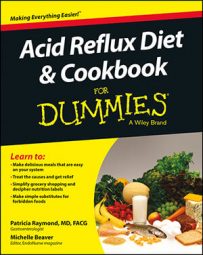All right, here’s the direction you want to go: adding, instead of depriving. Unless you hate one of the foods mentioned here, add all of them to your pantry, fridge, and freezer before you start the acid reflux diet.
Bananas
Well, you just know these suckers are healthy. Many fruits are high in acid and, therefore, bad for reflux sufferers, but bananas are quite tame.
One medium banana only has 110 calories and 1 gram of protein. Bananas have no cholesterol and no sodium. They’re high in potassium — and healthy levels of potassium can reduce blood pressure and reduce risk of stroke. Potassium also preserves bone mineral density, reduces the chance of kidney stone formation, and protects against muscle loss.
Fennel
Fennel is a perennial, nice-smelling herb that has yellow flowers. In root form, it looks a little like a cross between celery, an onion, and a turnip.
![[Credit: Illustration by Elizabeth Kurtzman]](https://www.dummies.com/wp-content/uploads/443171.image0.jpg)
Dried fennel seeds are often used in cooking. They have a flavor similar to anise. Fennel is great for warding off digestive problems such as heartburn (ahem), gas, bloating, and colic. Fennel may even soothe the coughing associated with acid reflux.
Leafy greens
Leafy greens are very mild on the pH scale, and that makes them a big yes for people who don’t want acid reflux. Plus, not a big surprise: Eating leafy greens is good for you in general.
Leafy greens promote intestinal health and strong immune systems. All of them are healthy, but kale may be the best. This underrated green contains calcium, folate, potassium, and vitamins A, C, and K.
Melons
European settlers in the New World grew honeydew and casaba melons, and Native Americans in New Mexico grew (and still grow) their own melon cultivars (varieties). Like bananas, melons are very mild because they’re pH friendly. That mildness makes them soothing.
Oatmeal
Oatmeal is gentle, and for that reason, it’s especially good for people who have acid reflux, but it’s also an overall healthy food. Oats are high in fiber, but not the kind of fiber that causes gas, so this is a low-bloat food. Oats are high in magnesium and anti-inflammatory.
Tofu
Again, neutrality is the theme. Tofu is a low-acid food. Very low. Plus, it’s a fantastic source of protein. So, instead of getting your protein only through fatty sources such as red meat, try mixing things up by bringing tofu into your diet.
Think of tofu like a potato — it’s tasteless alone, but flavor it up and cook it properly and you have a nice little flavor vessel.
Rice
There are so many types of rice, and not one — not one! — is an acid reflux trigger. It’s the way that people flavor and cook rice that can make it bad for reflux. Fried rice, for instance, can trigger acid reflux (because it’s fried), and Spanish rice can as well (because it has a lot of tomato and can also have onions, chili, and garlic).
Avocado
There are lots of reasons to love avocados. Chief among them: They have monounsaturated fat (a good fat) that can reduce bad cholesterol levels.
Avocado is bland on its own, but it comes alive with just a bit of salt. And of course, it’s delicious when made into guacamole. Guacamole often contains garlic, jalapeños, lime, and onion, though, so include less guacamole in your diet, or avoid it completely.
That doesn’t have to change your Mexican food much, though — simply smash the avocado and combine with salt and it will still be wonderful with those tortilla chips, in burritos, or on tacos.
Non-hydrogenated products
Non-hydrogenated products have fat that stays solid at room temperature. So, to eliminate these products from your diet, you need to avoid butter, lard, vegetable shortening, frosting, and the many baked foods that contain them. The most common way to consume hydrogenated fats is in baked goods. Simply replace these foods with non-hydrogenated products or eat extremely small quantities.
Nutritious oils
Instead of consuming hydrogenated products, consume nutritious oils instead. Every liquid oil is healthier than fats that are solid at room temperature, so cut out that vegetable shortening and reach for the corn oil or vegetable oil instead. Nut and seed oils are also good choices, and olive oil is the best.
All oil is high in fat, so even nutritious oils should be consumed in moderation.
Licorice root
The quintessential flavor of real licorice comes from the oil in the woody part of the licorice plant. However, many “licorice” products are actually flavored with anise oil, which tastes similar to licorice (and similar to fennel, coincidentally).
The licorice that’s best for acid reflux is licorice the plant. The plant is used to flavor foods, and the root is used to make medicine. Licorice root can treat digestive disorders such as heartburn, stomach inflammation, constipation, and ulcers. It’s also used in throat lozenges and teas to soothe the throat. Licorice root not only helps prevent acid reflux, but also helps ease symptoms if acid reflux does occur.
Parsley
Parsley is an herb that has been used as food and medicine for thousands of years. Parsley is used in many cultures to treat a wide variety of illnesses, from urinary tract infections to gastrointestinal illnesses such as indigestion and constipation. Parsley can also soothe the throat, which is partly why it’s good for people with acid reflux.
Parsley is much more than a plate decoration. It contains oils and flavonoids that give it medicinal properties.
This leafy green is native to the Mediterranean area and was used as medicine before it was used as a food. A food, however, it is, and a healthy one at that. Parsley is healthier fresh than dried. Flat-leaf parsley and its bushier “curled parsley” counterpart (the leaves of curled parsley are thicker, darker, and scrunched up) are equally healthy.

